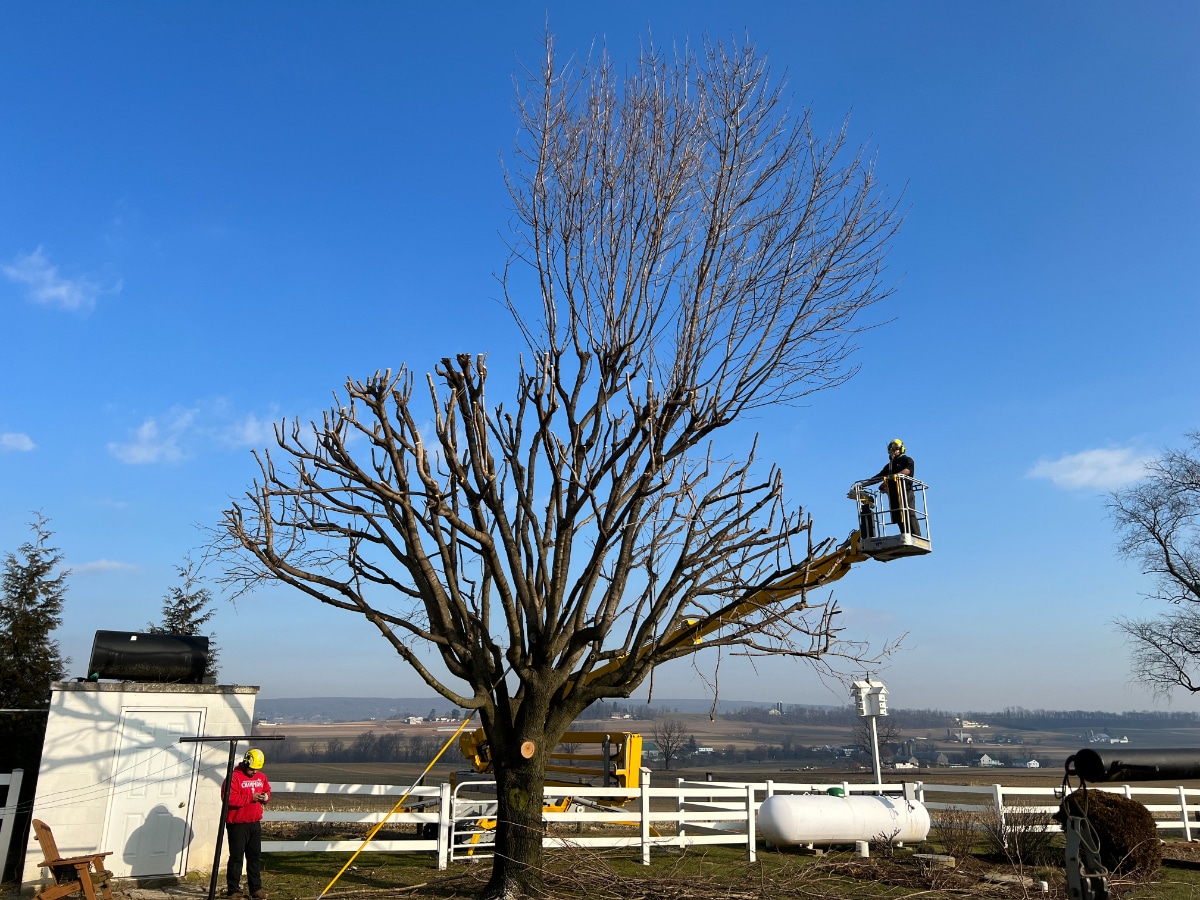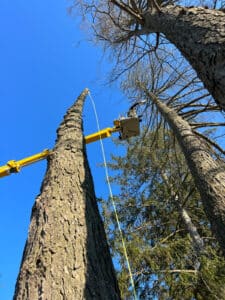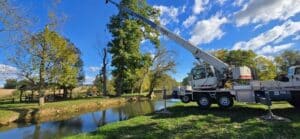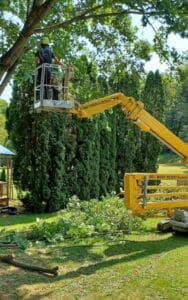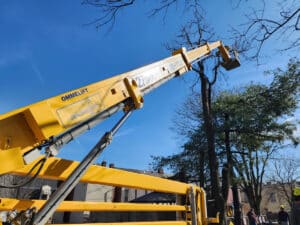Takeaways
- Trees can be problematic for one of two reasons: they are either a messy tree or create annoyances for homeowners, or they are invasive and detrimental to our broader Southeastern PA environment.
- Trees like willows and maples are some of the most common that we take down or trim back thanks for the volume of leaves and litter they produce, plus their destructive root systems.
- Invasive trees like Tree of Heaven are to be avoided completely, and we include the full PA DNR invasive species list below.
The Worst Trees and Tree Species (and Reasons) In Lancaster County
If you’ve had a problem tree on your property, you know the feeling. From weak branches that are constantly falling, to messy trees that litter your yard with debris, and aggressive roots that are slowly destroying your asphalt, trees affect us in a wide variety of ways. Choosing the wrong tree can lead to potential issues – and regrets!
Ash trees, for example, are known for their quick growth, beautiful fall colors, and clean, rounded shape. However, they’re under threat from the emerald ash borer in our area. This destructive insect is decimating the population of ash trees and causing cities to cut down thousands of dead ash trees despite regular and expensive treatment efforts.
While trees and other plants offer much-needed shade and beauty, not all are created equal. As a Lancaster County tree service company with nearly three decades of experience, we’ve seen it all. For this article, we’ll focus on tree species that are problematic for one of two reasons: common issues that we help homeowners address (limbs, tree roots, etc), and invasive plants (non native plants) that are detrimental to our Lancaster County environment.
Messy and Breakable Trees: Maintenance or Future Problems
These are the messy trees that we most frequently get called out to work on, as they create a mess with their large leaves, acorns, flowers, fruit, and pollen. Some tree species, like sweetgum trees and honey locust trees, produce round, hard, and spiky seed pods that are difficult to clean up and navigate around, especially in the fall and winter. That’s for a variety of reasons, but it often comes down to mess, damage, or size.
Willow Trees

Willow trees, including varieties like the weeping willow, are known for their invasive and thirsty, destructive root systems that seek out water sources, often clogging sewer pipes and damaging sewer lines. Their invasive roots frequently get into or around septic tanks.
Because they grow extremely quickly, their branches are also quite brittle, posing a risk during high winds and storms by easily breaking off and potentially causing storm damage. Many homeowners want them gone once they’ve gotten large, and willows are common trees that we trim back or take down entirely.
Maple Trees

Maple trees like the Silver Maple are a fast growing tree and popular for that reason, which might seem advantageous but often results in weak wood that is prone to breaking during storms, causing wind damage. And, their destructive roots can disrupt sidewalks, driveways, and foundations.
Additionally, they frequently drop branches and tree leaves, creating maintenance issues for and extra work for property owners. These roots also get in the way of trying to grow grass because they stay close to the surface.
Invasive Species: The Worst Trees to Plant In Your Yard
As arborists and tree experts, we understand that not all trees are suitable for planting in a home garden due to various issues such as size, debris production, aggressive roots, and invasiveness. But it’s the invasive trees and non native species that worry us most. Certain trees were not MEANT to be here in Lancaster and Southeastern PA, and they can take over if left unchecked. The highly invasive trees below are top of our black list.
Amur Maple (Acer ginnala)
A small, ornamental, even beautiful tree known for its attractive fall color and adaptability to a range of soil and weather conditions. Its ability to produce numerous seeds that disperse widely makes it a competitive threat to native plant species by dominating understory vegetation.
Sycamore Maple (Acer pseudoplatanus)
Sycamore maple is a robust tree appreciated for quick growth and resilience in urban settings. It becomes invasive by spreading vigorously and forming dense stands that suppress native trees and plants through heavy shading and nutrient uptake.
Siberian Elm (Ulmus pumila)
Siberian elm is utilized for its rapid growth and ability to thrive in harsh conditions, often used as a windbreak. Its invasive nature stems from its prolific seed production and high adaptability, allowing it to outcompete and displace native tree species in many environments.
Norway Maple (Acer platanoides)
The Norway maple is favored in urban landscapes for its tolerance to pollution and dense, shade-providing canopy. However, it outcompetes local flora due to its dense canopy which blocks sunlight to the undergrowth and alters soil chemistry to its advantage.
European Black Alder (Alnus glutinosa)
The European black alder thrives in wet environments, often stabilizing streambanks with its fast-growing roots. Its tendency to form dense thickets can lead to reduced biodiversity in aquatic and riparian zones, outcompeting native species for space and resources.
Tree of Heaven (Ailanthus altissima)
Tree-of-heaven is a fast-growing, weak wooded tree that tolerates poor soils and urban pollution, making it a common invader and street tree. It produces allelopathic chemicals that inhibit the growth of nearby plants, leading to monocultures and a significant reduction in local biodiversity.
Mimosa (Albizia julibrissin)
Mimosa is known for its beautiful, feathery foliage and fragrant pink flowers; however, it spreads aggressively along roadsides and disturbed habitats, outcompeting native species and often becoming a management issue in natural areas.
Japanese Angelica Tree (Aralia elata)
Japanese angelica tree is easily recognizable by its large compound leaves and spiny trunk. This tree’s prolific seed production and rapid growth allow it to dominate forest understories, disrupting native plant communities and ecological balances.
Paper Mulberry (Broussonetia papyfera)
Paper mulberry is often planted for its unique textured bark and broad leaves. It becomes problematic as an invasive species by spreading rapidly through root suckers and seeds, which can quickly overtake and displace native vegetation.
White Mulberry (Morus alba)
White mulberry grows quickly and is often used in urban environments for its hardiness. Its ability to hybridize with native red mulberries poses a genetic threat to the native species, potentially leading to their decline through hybrid swamping.
Princess Tree or Empress Tree (Paulownia tomentosa)
Princess tree or Empress tree spreads aggressively through its wind-dispersed seeds, quickly colonizing areas and outcompeting native species by monopolizing resources.
Cork Tree (Phellodendron amurense, P. japonicum, P. lavallei)
Cork trees produce large amounts of seeds that germinate rapidly, leading to dense populations that can dominate ecosystems and push out native flora.
Callery or Bradford Pear Tree (Pyrus calleryana)
Bradford pear or ornamental pear is known for its beautiful flowers and symmetry in landscape design. The callery pear becomes invasive by spreading vigorously beyond intended areas, forming dense thickets that displace native species and disrupt local ecosystems.
Fix Your Trees or Eliminate them Entirely – Call Sunny Slope!
Don’t let tree troubles take you by surprise.
Whether it’s the peril of falling branches, the nuisance of messy droppings, or the frustration of cracked sidewalks, our expert team at Sunny Slope Tree Service is here to help. We specialize in managing and removing problematic trees (stump removals, tree trimming, and more! to keep your property safe and serene.
Schedule your free tree consultation today and ensure peace of mind through every season.

